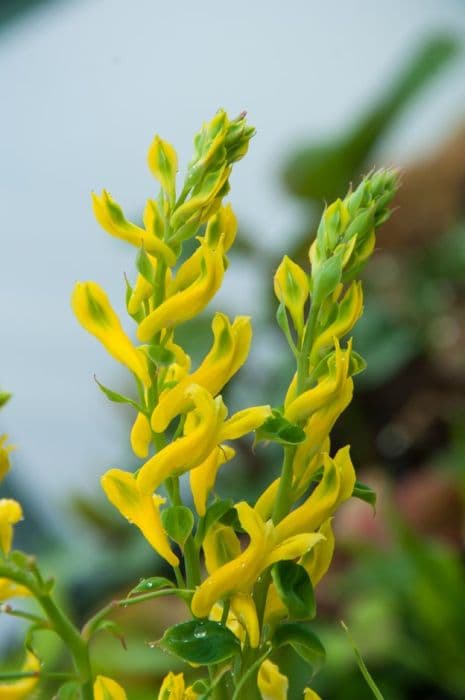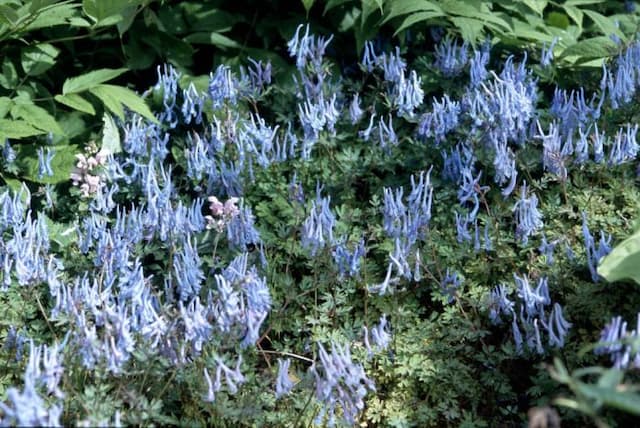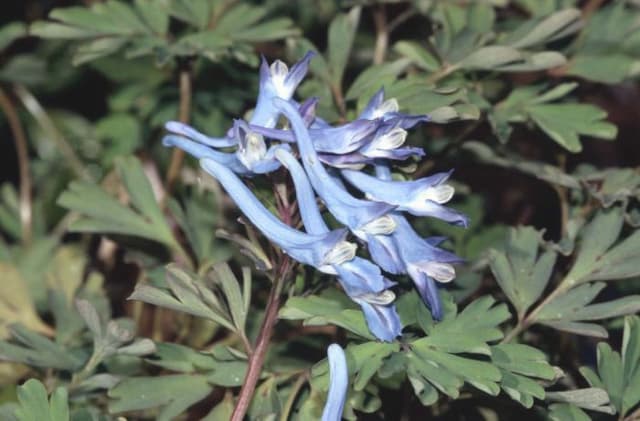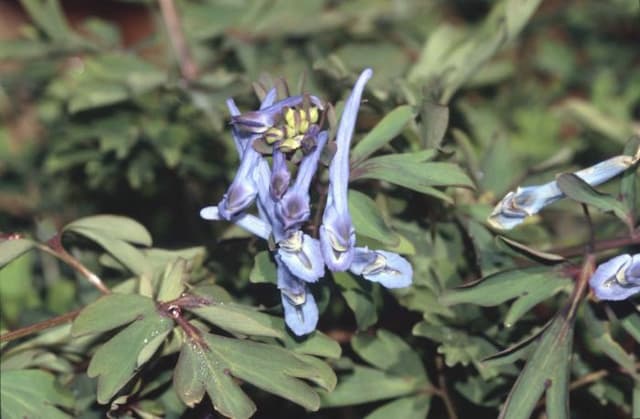Yan Hu Suo Corydalis wilsonii
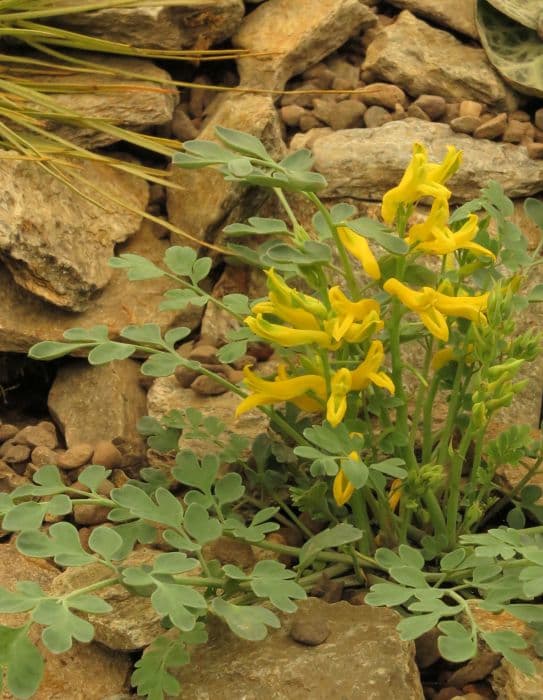
ABOUT
Corydalis wilsonii, known commonly as Wilson's Corydalis, is a plant that has a distinct and attractive appearance. It features a mound of delicately divided, fern-like foliage that tends to be a bright or blue-green color, creating an intricate and soft background for its blooms. The leaves are often biternate, meaning they are divided thrice into three smaller leaflets, offering a delicate, lacey texture to the overall look of the plant. The flowers of Wilson's Corydalis are particularly noteworthy, often appearing in clusters on slender, arching stems that rise above the foliage. These blooms can come in a variety of colors, ranging from soft pastel shades to more intense hues. The flowers themselves are tubular with a spurred back, resembling small elongated hearts or miniature gladioli, and they are neatly spaced along the stems. Each blossom has a spurred petal that lends an elegant and unique character to the overall floral display. The flowering period of Wilson's Corydalis adds a vibrant touch to the garden when many other plants may not be in peak display. The seeds of Wilson's Corydalis are contained in small pods that follow the flowers, adding another point of interest later in the season, although they are less showy than the flowers themselves. Overall, Wilson's Corydalis is a charming and ornamental plant that can bring a lovely aesthetic with its detailed foliage and beautiful, delicate flowers. Its appearance can add texture and color to garden beds and borders, creating visual appeal throughout its growing season.
About this plant
 Names
NamesFamily
Papaveraceae.
Synonyms
There are no widely recognized common names for Corydalis wilsonii, it is typically referred to by its scientific name.
Common names
Corydalis wilsonii
 Toxicity
ToxicityTo humans
Corydalis (Corydalis wilsonii) toxicity in humans is not well-documented, and there is limited information available on its specific effects. However, many plants in the Corydalis genus contain alkaloids that can be toxic, so caution is advised when handling or ingesting unknown Corydalis species. The general symptoms of alkaloid poisoning may include nausea, vomiting, dizziness, fainting, and potentially more severe reactions depending on the amount consumed and individual sensitivity. Always consult with a medical professional or poison control center if ingestion occurs.
To pets
Corydalis (Corydalis wilsonii) may also be toxic to pets, as it potentially contains alkaloids that can be harmful if ingested. Pets, such as dogs and cats, may experience symptoms similar to those in humans, including gastrointestinal upset, vomiting, diarrhea, central nervous system depression, and potential changes in heart rate or rhythm. If you suspect your pet has ingested this plant, contact a veterinarian or a pet poison hotline immediately.
 Characteristics
CharacteristicsLife cycle
Perennials
Foliage type
Deciduous
Color of leaves
Green
Flower color
Yellow
Height
1-2 feet (30-60 cm)
Spread
0.5-1 feet (15-30 cm)
Plant type
Herb
Hardiness zones
5
Native area
China
Benefits
 General Benefits
General Benefits- Ornamental value: Corydalis wilsonii, known as Yellow Corydalis, can enhance the aesthetic appeal of gardens and landscapes with its attractive foliage and vibrant yellow flowers.
- Habitat support: Yellow Corydalis can provide habitat and food for pollinators such as bees and butterflies.
- Soil improvement: Like other plants, Yellow Corydalis can contribute to soil health by adding organic matter through leaf and root decay.
- Ecosystem diversity: By adding Yellow Corydalis to a garden, it can contribute to plant diversity, which can in turn support a wider range of wildlife.
- Seasonal interest: Yellow Corydalis blooms in the spring, providing early color and interest in the garden after winter.
 Medical Properties
Medical Properties- Analgesic: Corydalis wilsonii is known to contain alkaloids that may have pain-relieving properties.
- Sedative: It may have a sedative effect, potentially aiding in sleep or reducing anxiety.
- Cardiovascular: There are references to its use in traditional medicine for supporting heart health and improving circulation.
- Gastrointestinal aid: Traditionally, it might have been used to treat stomach issues and improve digestion.
- Anti-inflammatory: The plant is thought to contain compounds that could help in reducing inflammation.
 Air-purifying Qualities
Air-purifying QualitiesThis plant is not specifically known for air purifying qualities.
 Other Uses
Other Uses- Corydalis wilsonii can be used in ornamental gardens for its attractive foliage and delicate flowers, adding an aesthetic appeal to garden beds and borders.
- The plant can serve as a natural indicator of the changing seasons, as it flowers in the spring, signaling the arrival of warmer weather.
- In educational settings, Corydalis wilsonii may be used for botanical studies due to its interesting morphological features, such as its tubular flowers.
- This species can play a role in butterfly gardens, as its flowers may attract certain species of butterflies and other pollinators.
- Corydalis wilsonii can be cultivated for use in floral arrangements, especially in regions where it grows natively and is readily available.
- Gardeners may use Corydalis wilsonii in rock gardens, as this plant is capable of thriving in the nooks and crannies of rocky terrains.
- As a component in shade gardens, this plant can add color and life to areas under trees or in the shadows of buildings where sunlight is limited.
- Photographers and artists may find inspiration in the delicate beauty of Corydalis wilsonii, using it as a subject in their creative works.
- Seed collectors may be interested in Corydalis wilsonii for its seeds, which can be part of a seed exchange or conservation effort.
- Due to its non-invasive nature, Corydalis wilsonii could be recommended for planting in areas where gardeners wish to avoid aggressive spreaders.
Interesting Facts
 Feng Shui
Feng ShuiThe Corydalis is not used in Feng Shui practice.
 Zodiac Sign Compitability
Zodiac Sign CompitabilityThe Corydalis is not used in astrology practice.
 Plant Symbolism
Plant Symbolism- Enduring Love: Corydalis plants often symbolize an enduring or persistent love, as many species in this genus have a resilient nature, with some able to grow in difficult conditions.
- Tranquility: The delicate appearance of Corydalis flowers, possibly including Corydalis wilsonii, can symbolize peace and tranquility, suggesting a calm and serene presence.
- Happiness: With their bright and cheerful flowers, Corydalis species can be seen as a symbol of happiness and joy, bringing a positive vibe to gardens and natural settings.
- Hope: The way some Corydalis species, such as Corydalis wilsonii, emerge through tough soils can symbolize hope and the idea that there is potential for life and beauty even in hard circumstances.
 Water
WaterFor Golden Corydalis, water thoroughly when the top inch of soil feels dry to the touch, typically once a week. During the growing season in spring and summer, this plant appreciates consistent moisture, so weekly watering with approximately one gallon per plant should suffice, depending on the size and type of container. Decrease watering in the fall and winter to every other week or less, as the plant enters dormancy and requires less water. Always avoid waterlogged conditions as this can lead to root rot.
 Light
LightGolden Corydalis thrives in part shade to full shade conditions. It prefers to be sheltered from harsh midday sun, making an east-facing garden spot ideal where it can receive gentle morning light and be protected during the hottest part of the day. Dappled sunlight under a canopy of trees or a shaded porch are also excellent spots for this delicate woodland plant.
 Temperature
TemperatureGolden Corydalis fares best in temperate conditions, thriving in temperatures ranging between 50°F and 75°F. It can tolerate short periods of colder weather down to about 32°F and should be protected from frost. To ensure optimal growth, avoid exposure to temperatures above 80°F, as excessive heat can stress the plant.
 Pruning
PruningPruning Golden Corydalis is generally done to remove spent flowers and encourage further blooming. Lightly prune or deadhead after the first flush of flowers in late spring to early summer to promote a second bloom. Pruning is minimal and often only necessary to maintain the shape and health of the plant, doing so when necessary throughout the growing season.
 Cleaning
CleaningAs needed
 Soil
SoilFor Wilson's Corydalis, prepare a well-draining soil mix with high organic matter content. The ideal pH range for Wilson's Corydalis should be slightly acidic to neutral, around 5.5 to 7.0. A mix of loamy garden soil, peat, and perlite or sand can work well to ensure proper drainage and aeration.
 Repotting
RepottingWilson's Corydalis typically needs repotting every 2-3 years. It's best to repot in the spring when the plant is emerging from dormancy. This allows the roots to recover and establish themselves in the new potting medium.
 Humidity & Misting
Humidity & MistingWilson's Corydalis thrives in moderate to high humidity levels. Aim to maintain humidity around 50-70% for optimal growth. This plant prefers a somewhat humid environment but can tolerate short periods of lower humidity.
 Suitable locations
Suitable locationsIndoor
Place Wilson's Corydalis near bright, indirect light and keep the soil moist.
Outdoor
Plant in partial shade and moist, well-drained soil.
Hardiness zone
5-8 USDA
 Life cycle
Life cycleCorydalis wilsonii, commonly referred to as Wilson's Corydalis, begins its life cycle as a seed, which under suitable conditions—typically in moist and well-drained soil—will germinate and develop into a seedling. The seedling stage is characterized by the emergence of the plant’s initial true leaves as it utilizes the nutrients stored in the seed. Following the seedling stage is the vegetative stage where the plant undergoes rapid growth, developing a rosette of leaves and a root system that prepares it for flowering. In the next stage, the flowering stage, Wilson's Corydalis produces colorful flowers, often in the late spring or early summer, which attract pollinators for sexual reproduction. The subsequent fruiting stage sees the formation of dehiscent fruit capsules containing seeds that, when mature, are dispersed by various means, such as wind or water. Lastly, after fruiting, the plant enters a period of dormancy, particularly in regions with cold winters, only to restart its cycle with the advent of more favorable spring conditions.
 Propogation
PropogationPropogation time
Spring to Summer
For Corydalis wilsonii, commonly known as Wilson's Corydalis, the most popular method of propagation is by seed. The best time to sow seeds is in the fall, directly after they are ripe to take advantage of natural stratification over the winter months. The seeds should be sown in a cold frame or a similarly protected environment. They require a period of cold dormancy to break seed dormancy, a process which is facilitated by the cool temperatures and natural temperature fluctuations of the season. Once the seeds have undergone this stratification process, they typically germinate in the spring as temperatures rise. It is important to keep the sown seeds moist but not waterlogged, and once seedlings have emerged, they should be cared for until they are strong enough to be transplanted to their final growing position in the garden.
